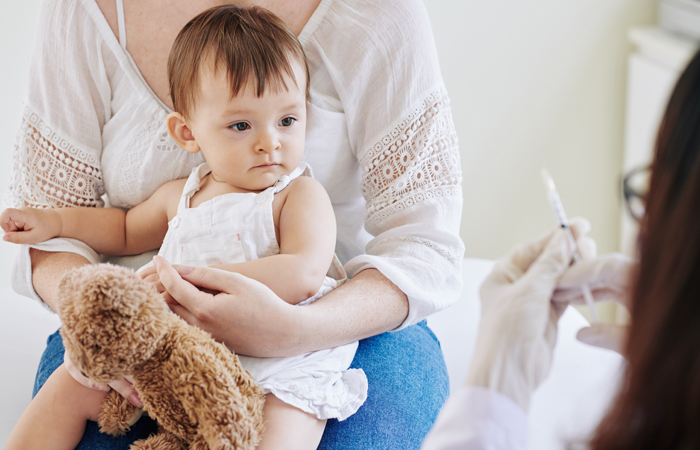OTC

Keeping the doctor away
In OTC
Bookmark
Record learning outcomes
The age-old saying of an apple a day keeps the doctor away is as pertinent as it’s ever been, but other aspects of children’s health are very different to how they were 100, 50 or even 10 years ago
The health of babies, children and teenagers in the UK has improved dramatically over the last 100 years. At the beginning of the 20th century, one in six babies in the UK didn’t live until their first birthday. That statistic has now fallen to only one baby in 256 and similar improvements have been seen throughout the childhood and teenage years.

However, according to the Royal College of Paediatrics and Child Health (RCPCH)’s State of Child Health report in February 2017, there is still major cause for concern. Particularly troubling are the stark inequalities in child health that have widened in the last five years.
What’s more, a child’s physical and mental health inevitably influences their physical and mental health in later life. Around 80 per cent of overweight or obese children will become overweight or obese adults, increasing their risk of serious life-long health conditions, such as type 2 diabetes, heart disease and some cancers. And, according to the State of Child Health report, half of adult mental health problems start before the age of 14, and 75 per cent start before the age of 27. For this reason, it’s essential to tackle health issues in childhood as soon as they arise.
Immunisation rates
“In many ways, over the last 10 years, we have done extremely well in reducing cases of infectious diseases through routine immunisation programmes,” says Dr Rahul Chodhari, consultant paediatrician and spokesperson for the RCPCH. In September 2017, NHS Digital statistics showed that the proportion of children receiving the measles, mumps and rubella (MMR) vaccine by age five has increased year on year since 2006-7, with coverage at 95 per cent in 2016-17, meeting the World Health Organization (WHO) recommended target.
However, coverage of the MMR vaccine by children’s second birthdays decreased in 2016-17 for the third year in a row to 91.6 per cent. In addition, Dr Chodhari adds: “There are still record numbers of children with respiratory infections, often related to the flu, or illnesses relating to malaria or typhoid from immigration. There have also been recent reports of whooping cough and measles, with outbreaks in smaller communities and in countries where vaccination rates are low.”
To provide the best protection of children and the community as a whole, uptakes of MMR and the primary vaccines need to remain high. This stops diseases circulating within a community, protecting those who can’t be immunised or who have a higher risk of complications, such as babies. In November 2017, research in The Lancet Infectious Diseases warned that England is experiencing an unprecedented rise in scarlet fever, with the highest incidence for nearly 50 years. In the same month, there were measles outbreaks in five areas across the UK, with cases continuing to rise in January 2018.
Community pharmacy teams can play an important role in supporting immunisations by discussing the benefits with their customers. “Some areas could benefit from improvement, especially in children from more deprived backgrounds,” says Dr Chodhari. “Many factors are influencing national, and local, vaccination rates. For example, very few young parents have seen anyone with these diseases so don’t fully understand the risks of not vaccinating their children. Also, they hear about the side effects of vaccinations, which are rare but made more prominent by media coverage.”

Diet and obesity
According to Tam Fry, patron of the Child Growth Foundation and National Obesity Forum chairman, the state of children’s obesity is progressing from awful to worse. “Junk food, fizzy drinks and lack of physical activity are the chief villains in the rise of childhood obesity,” he says. “Childhood obesity tracks into adulthood and if obese children or teenagers haven’t already contracted type 2 diabetes, heart conditions, liver diseases et cetera, they face acquiring them in early adulthood.”
Latest figures from the National Child Measurement Programme (NCMP) in England show that obesity prevalence was more than twice as high among children in year six than in reception age children, where more than one in three children were either overweight or obese in 2016-17. While obesity can affect all areas of society, there are clear gaps between the rich and the poor. In 2015-16, some 40 per cent of children in England’s most deprived areas were overweight or obese, compared with 27 per cent in the most affluent areas.
“Obesity is a common issue,” says Dr Chodhari. “More children are living in relative poverty in our society, and inequality has a huge role to play in this. We are seeing everything in the extreme, from malnourishment due to inadequate food intake to obesity and dental health concerns due to poor awareness of nutrition and healthy eating. Childhood obesity is often multi-factorial, caused by a number of things including highly processed food and a significant reduction in exercise. Children from poorer backgrounds are less likely to have access to nutritional food or opportunities to exercise.”
“The Government says that tackling obesity is a priority,” says Caroline Cerny, alliance lead at the Obesity Health Alliance. “But a real commitment to tackling obesity means also getting to grips with the environment in which our children grow up. Adverts for unhealthy foods have a significant impact on consumption habits, and we want to see immediate action to restrict junk food marketing at children – both online and on TV before the 9pm watershed.”
Children and teenagers who are already overweight or obese need to be able to access the right support and treatment to lose weight and keep it off for life. “Community pharmacies could help hugely by offering body mass index (BMI) checks and explaining to or educating parents the way in which BMI can, over time, identify the first signs of excess weight before it becomes a problem,” says Tam. “This should be done by GPs or in schools but isn’t. Children are just left to put on further weight until they become an obesity statistic.”
Dental health
Community pharmacies are well placed to offer advice on oral health to parents, as well as the best products for a daily oral health routine. Despite tooth decay being almost entirely preventable, 31-41 per cent of five-year-old children across the UK have evidence of tooth decay, with rates higher for those in deprived populations. Tooth decay is the single most common reason why children aged five to nine require admission to hospital. New figures issued by the Local Government Association in January 2018 revealed that there were nearly 43,000 hospital operations to remove unhealthy teeth in children and teenagers in the last year – this translates to 170 operations a day.
Chief executive of the Oral Health Foundation, Dr Nigel Carter OBE, says the two issues contributing to the problem are excessive sugar consumption and a lack of proper oral health education. “In addition to the pain and distress caused for the children undergoing these operations, the cost of dealing with the problem is becoming dangerously unsustainable for the NHS,” he says. “By developing better education for children on issues such as how much sugar is in their diets and how best to look after their oral health, the vast majority of these operations can be completely avoided.”
Mental health

According to YoungMinds, almost one in four children and young people show some evidence of mental ill health, including anxiety and depression. The State of Child Health report revealed that mental health is a major area of concern for children and teenagers, particularly issues around self-esteem and self-confidence, and many children and teenagers worry about how to deal with mental health concerns and who to turn to for advice.
“Mental health problems have become increasingly common,” says Dr Chodhari. “Young people talk about pressure being a trigger. It’s important to note that pressure in itself isn’t a bad thing but sometimes it can overwhelm young people. There’s usually not just one trigger – young people talk about school, social, family and media pressures. Part of the adolescent’s journey is conforming to peer pressure. This is nothing new, but social media can create a sense of inadequacy, increasing stress and anxiety, especially as it penetrates into the home behind closed doors.”
According to children’s mental health charity Place2Be, low self-esteem affects more than eight in 10 of the pupils who access its one-to-one support and can result from social and school pressures as well as more serious issues. “Difficult experiences in childhood, including bereavement, domestic violence or neglect, can also have a serious impact, often several years down the line,” says Dr Marc Bush from YoungMinds. “To make matters worse, it can be extremely difficult for teenagers to get the right support if they’re struggling to cope. That’s why it’s crucial that mental health services are properly funded, with a focus on early intervention.”
The Government is currently asking people for their views on a green paper setting out measures to improve mental health support for children and young people. The green paper focuses on earlier intervention and prevention.
However, Tom Madders, director of campaigns at YoungMinds, says the Government’s proposals in the green paper are promising but don’t go far enough. “We hear from parents on our helpline everyday who tell us that they’ve been waiting months for an appointment, and simply don’t know where to turn. Often they tell us that their children have started to self-harm or become suicidal during the wait – or that they’ve dropped out of school – which not only has a huge impact on their education, but also means that one of the parents has to give up their job to look after them.”
Community pharmacies can get involved in national campaigns on mental health, including those focusing on children and teenagers. Superdrug pharmacist Kathryn Granleese says community pharmacies are in a great position to provide mental health support. “By completing CPPE training on mental health it will equip them with the ability to spot triggers of children in their care,” she says. “This, alongside regular training with the whole pharmacy team, can ensure community pharmacies are able to provide up-to-date support for mental health and wellbeing. Pharmacies can also choose to run health campaigns around mental health where the pharmacy community can really raise awareness and start important conversations.”
Around 80 per cent of overweight or obese children will become overweight or obese adults
